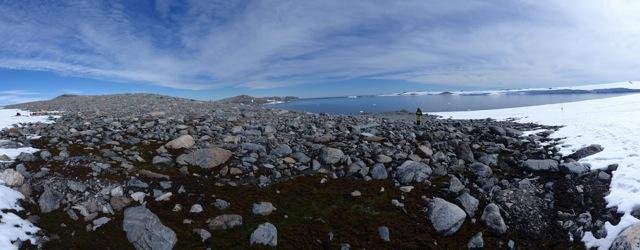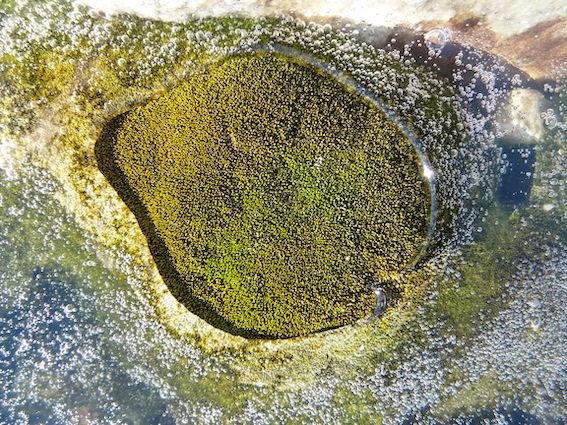Displaying items by tag: photosynthesis
Even in Antarctica - it’s hot in the sun!
We know that Antarctica is the frozen planet and we tend to think that its animals and plants must also be well adapted to cold conditions. As a result we probably assume that they do better in cold conditions than other plants or animals. But is that really true?
Working with mosses, the main plants, in Antarctica I have often wondered this? I know they are amazing at surviving the cold. Try putting your salad vegetables in the freezer and you quickly see that many plants are very bad at tolerating freezing. Some plants are even damaged by chilling temperatures above zero (fridge temperatures). But we can collect Antarctic mosses, dry them and put them in the freezer and then take them out after a few months, or more than 50 years, and they will grow again! So yes, they can tolerate freezing conditions - they put up with about 8 months a year in nearly complete darkness and temperatures as low as -40˚C
But that doesn’t mean they like it cold. Are they just able to tolerate cold but would be more productive if summers were warmer? If so, can they warm themselves up above those usually chilly summer air temperatures of 1-2 40˚C? Are they really in Antarctica because they can survive the cold winters while other plants can’t? In which case its more about lack of competition from flowering plants than actually being truly cold loving.
Professor Barry Osmond
|
Ph: 02 4221 4444
|
 |
Dr Melinda Waterman
|
I am an early career biotechnologist examining the secondary metabolites and protective mechanisms of moss species that live in temperate and Antarctic regions. I recently completed my PhD in the biology and chemistry of Antarctic moss species, with a focus on their natural protective mechanisms and how old living moss shoots from Antarctica can be. I am interested in the protective mechanisms employed by plants, in particular mosses, and how they cope in different stressful situations, e.g. UV radiation, water stress and high light. My research interests include but are not limited to climate change, plant ecophysiology, radiocarbon dating and natural products spanning across many disciplines within science. Ph: 02 4221 5373 Position: Research Associate / Associate Lecturer
|
 |
17th International Congress on Photosynthesis Research
I recently returned from this year’s ICPR conference held in Maastricht in the Netherlands. The photosynthesis congress is held every four years and hosts researchers involved in all aspects of photosynthesis research. In what was the largest poster room I have ever seen, I was lucky enough to present a poster on understanding the regulation of photosynthesis during sun-flecks. I was also lucky enough to present two talks on solar induced fluorescence (SIF) at both the main conference and a satellite meeting held in Essex the week prior.
Congratulations & Scientific Connections Part 2
On Wednesday we celebrated four graduands. Dr Mel Waterman and Dr Johanna Turnbull were awarded their PhDs. Professor Bob Furbank became Dr Dr Bob. He was awarded an Honorary Doctor of Science. In his inspiring graduation speech he told the graduands how important it was to try and work in an area which you love. I certainly agree with that sentiment. He also talked about the important part played by mentors, peers and of course serendipity.
Scientific connections Part 1
We had a very interesting meeting yesterday to discuss connections between the work Rhys Wyber and Barry are doing at the leaf level, Zbynek at the canopy level and satellite measurements. The question is how can we bridge the gap between these scales to help inform measurements of global productivity and carbon dioxide in the atmosphere.
Experiments in a natural cooler
Our time on King George Island is coming to an end and we are wrapping up some experiments that were focusing on salt, temperature, light and water stresses.
Field work in Ballina
Months of getting equipment ready have finally cumulated in 10 days field work at the scenic Summerland House Farm. Prof Barry Osmond (pictured) and I spent ten days in the field trying to understand photosynthesis in both the inner and outer canopies of Avocado trees. We were running all our equipment from four large car batteries which we charged overnight and lugged out to our field site each day. During the ten day campaign we were met with everything from clear summer days to golf ball sized hail and we often found ourselves rushing to the field site to ensure none of our equipment got wet. Overall though a successful field campaign with lots of promising data collected and a big thankyou to all the welcoming staff at Summerland Farm House and Alstonville Country Cottages.
Does the plant parasite Cassytha stress Leptospermum?
Melinda and Sharon have a new paper published with colleagues at the University of Adelaide. We helped Robert Cirocco, a PhD student from Adelaide, to extract photosynthetic pigments from an Australian native Hemiparasite Cassytha pubescensand its host plant Leptospermum myrsinoides. A hemiparasite plant is one which takes water and minerals from its host by taping into the xylem vessels that conduct water. It is not a full parasite because it is able to photosynthesise and make its own sugars.
Satellite signals of chlorophyll fluorescence?
Satellites provide a key method for measuring properties of the biosphere, atmosphere and hydrosphere on global scales. In particular, in recent years the detection and quantification of solar induced fluorescence (SIF) as a means to quantify plant growth and productivity has been a key goal of both NASA’s OCO-2 mission and the proposed European FLEX mission. However, the processes driving SIF are not fully understood.


